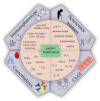Immunosenescence in Childhood Cancer Survivors and in Elderly: A Comparison and Implication for Risk Stratification
- PMID: 35822014
- PMCID: PMC9261368
- DOI: 10.3389/fragi.2021.708788
Immunosenescence in Childhood Cancer Survivors and in Elderly: A Comparison and Implication for Risk Stratification
Abstract
The population of childhood cancer survivors (CCS) has grown rapidly in recent decades. Although cured of their original malignancy, these individuals are at increased risk of serious late effects, including age-associated complications. An impaired immune system has been linked to the emergence of these conditions in the elderly and CCS, likely due to senescent immune cell phenotypes accompanied by low-grade inflammation, which in the elderly is known as "inflammaging." Whether these observations in the elderly and CCS are underpinned by similar mechanisms is unclear. If so, existing knowledge on immunosenescent phenotypes and inflammaging might potentially serve to benefit CCS. We summarize recent findings on the immune changes in CCS and the elderly, and highlight the similarities and identify areas for future research. Improving our understanding of the underlying mechanisms and immunosenescent markers of accelerated immune aging might help us to identify individuals at increased risk of serious health complications.
Keywords: accelerated aging; childhood cancer survivor; elderly; immunosenescence; late effects; low-grade inflammation; patient stratification.
Copyright © 2021 Lázničková, Bendíčková, Kepák and Frič.
Conflict of interest statement
The authors declare that the research was conducted in the absence of any commercial or financial relationships that could be construed as a potential conflict of interest.
Figures



Similar articles
-
The Role of Immunosenescence in the Development of Age-Related Diseases.Rev Invest Clin. 2016 Mar-Apr;68(2):84-91. Rev Invest Clin. 2016. PMID: 27103044 Review.
-
Immunosenescence, Inflammaging and Resilience: An Evolutionary Perspective of Adaptation in the Light of COVID-19 Pandemic.Psychiatr Danub. 2021 Spring-Summer;33(Suppl 4):427-431. Psychiatr Danub. 2021. PMID: 34718260
-
The twilight of the immune system: The impact of immunosenescence in aging.Maturitas. 2021 May;147:7-13. doi: 10.1016/j.maturitas.2021.02.006. Epub 2021 Feb 26. Maturitas. 2021. PMID: 33832647 Review.
-
The interplay between immunosenescence and age-related diseases.Semin Immunopathol. 2020 Oct;42(5):545-557. doi: 10.1007/s00281-020-00806-z. Epub 2020 Aug 3. Semin Immunopathol. 2020. PMID: 32747977 Free PMC article. Review.
-
Aging of the Immune System: Focus on Natural Killer Cells Phenotype and Functions.Cells. 2022 Mar 17;11(6):1017. doi: 10.3390/cells11061017. Cells. 2022. PMID: 35326467 Free PMC article. Review.
Cited by
-
Evaluation of respiratory exchange ratio (RER) for predicting postoperative outcomes in elderly patients undergoing oncological resection for gastrointestinal malignancies - A prospective cohort study.Indian J Anaesth. 2023 Mar;67(3):283-289. doi: 10.4103/ija.ija_609_22. Epub 2023 Mar 16. Indian J Anaesth. 2023. PMID: 37250513 Free PMC article.
-
The Tumor Microenvironment of Medulloblastoma: An Intricate Multicellular Network with Therapeutic Potential.Cancers (Basel). 2022 Oct 13;14(20):5009. doi: 10.3390/cancers14205009. Cancers (Basel). 2022. PMID: 36291792 Free PMC article. Review.
-
Late Complications in Long-Term Childhood Cancer Survivors: What the Oral Health Professional Needs to Know.Dent J (Basel). 2024 Jan 19;12(1):17. doi: 10.3390/dj12010017. Dent J (Basel). 2024. PMID: 38275678 Free PMC article. Review.
-
Effects of Korean red ginseng on T-cell repopulation after autologous hematopoietic stem cell transplantation in childhood cancer patients.J Ginseng Res. 2024 Jan;48(1):68-76. doi: 10.1016/j.jgr.2023.09.001. Epub 2023 Sep 9. J Ginseng Res. 2024. PMID: 38223820 Free PMC article.
References
Publication types
LinkOut - more resources
Full Text Sources

